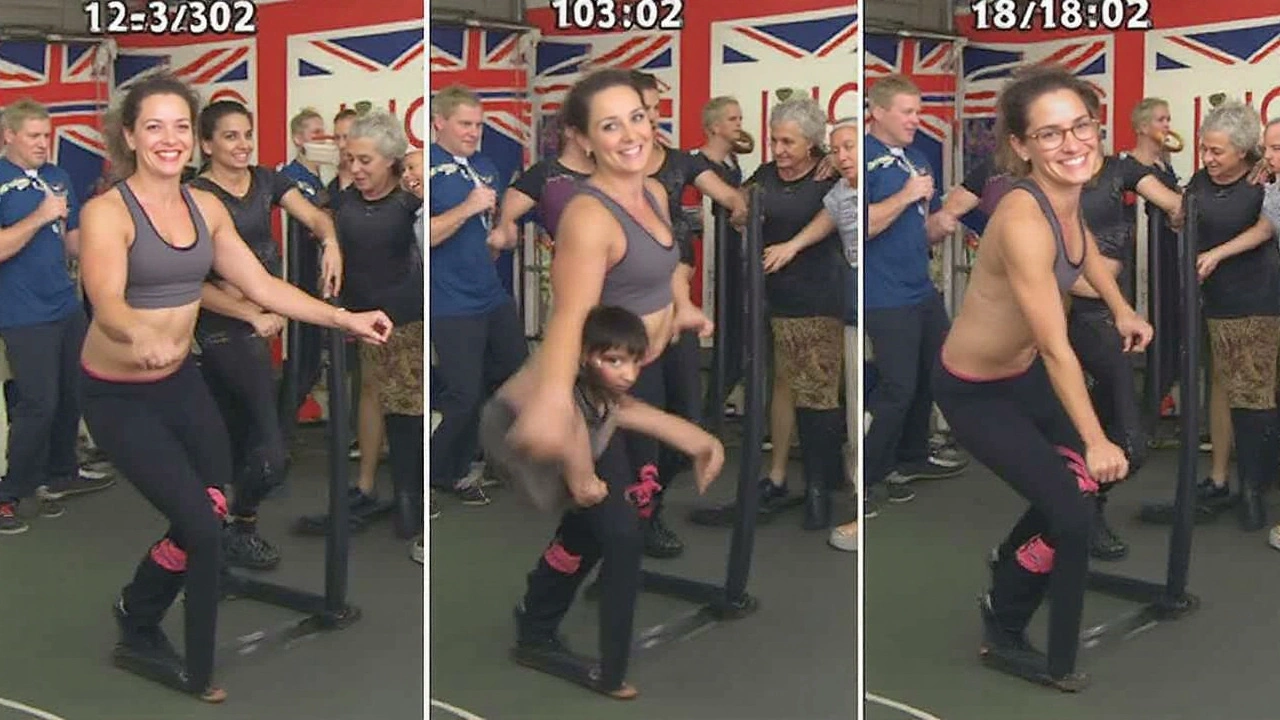
The search for an effective workout often leads fitness enthusiasts to the 12-3-30 routine—an efficient treadmill workout hailed for its simplicity and results. If you've caught the buzz but wonder how many times a week you should engage in this regimen to lose weight, you're not alone.
The secret lies in understanding not only the workings of this exercise but also how it fits into a balanced lifestyle. Integrating the right frequency with complementary habits can make all the difference.
- Understanding the 12-3-30 Workout
- Benefits of Regular Cardio Exercising
- Ideal Frequency for Weight Loss
- Tips for Incorporating 12-3-30 into Your Routine
- Pairing the Workout with a Healthy Lifestyle
Understanding the 12-3-30 Workout
At first glance, the 12-3-30 workout might seem like a string of random numbers, yet it sparks curiosity and excitement in the fitness community. This specific treadmill routine is named for its simple formula: adjust the machine to a 12% incline, set the pace at 3 miles per hour, and keep going for 30 minutes. The charm lies in its accessibility—it requires little more than determination and a treadmill. Designed by internet personality Lauren Giraldo, it quickly caught fire thanks to its effectiveness and simplicity. While more conventional routines might involve complicated equipment or varied exercises, 12-3-30 has won hearts because it feels approachable. But beneath its simplicity, there's more at play than just walking briskly. The steep incline forces the body to engage muscles like the calves, glutes, and hamstrings more intensely, turning an ordinary walk into a demanding workout.
These elements work together to boost the heart rate, creating the conditions for effective cardio workouts. Cardio exercise is a staple for burning calories and enhancing heart health, and 12-3-30 delivers on both fronts. Participants appreciate how this workout can be squeezed into a tight schedule without losing its punch. It's less about fast paces and more about endurance and persistence, which adds to its versatility. Therefore, whether someone is a fitness newbie or a seasoned runner, they can adapt this workout to their needs. Giraldo herself has shared its benefits, noting not just physical changes, but also increased mental clarity and energy levels in her experience. As with any routine, consistency is key—when practiced regularly and paired with mindful living, results are bound to follow. Those looking to kickstart their weight loss journey or revitalize their fitness regime often find solace in this minimalist yet effective regimen.
Benefits of Regular Cardio Exercising
Regular cardio exercise is the heart and soul of effective fitness routines, and it’s remarkably beneficial for those aiming to lose weight through the 12-3-30 workout plan. Engaging in cardio activities frequently is known not just for burning calories during the session but also for enhancing the body's ability to do so at rest. This happens because cardio exercises, like the 12-3-30 routine, ramp up your metabolic rate. A stronger metabolism means that your body becomes more efficient at using calories throughout the day, positively impacting those weight loss goals.
The benefits of cardio extend beyond just burning fat. It plays a crucial role in improving cardiovascular health, effectively lowering the risk of heart-related diseases, which is a leading concern worldwide. Engaging in exercises such as the treadmill-based 12-3-30 workout increases heart rate, enabling better blood flow and strengthening the heart muscle. This process not only spikes up energy levels by enhancing endurance but also helps in reducing stress, thanks to endorphin release. In times like today, managing stress is essential to maintaining both physical and mental health.
Interestingly, cardio workouts like this one do not require an extended duration for benefits to be noticeable. Studies suggest that even moderate-intensity exercises can lead to significant health improvements. A mere 150 minutes of activity per week meets the guidelines recommended by health organizations. This minimal investment in time makes routines like the 12-3-30 accessible for people with busy schedules who seek effective outcomes without unrealistic commitments. Moreover, there’s evidence to suggest that regular cardio can boost cognitive function and memory, creating a cascade of benefits impacting broader health aspects.
Cardio for Enhanced Emotional Well-being
Let’s not overlook the psychological lift that accompanies consistent cardio exercises. Science shows that cardio can alleviate symptoms of anxiety and depression. For anyone feeling weighed down by the everyday stresses of life, few remedies are as immediate and uncomplicated as a session on the treadmill. Ancient wisdom combined with modern science underscores that physical movement is essential for emotional stability. Exercising frequently encourages discipline and offers a natural mechanism for coping with life's pressures.
"Cardio exercises are a powerful tool for boosting mental health, aiding in emotional resilience," says Dr. Jane Doe, a well-respected psychologist specializing in stress management.
Incorporating regular cardio through these workouts builds resilience and determination. The very act of committing to a fitness regime provides a goal-driven mindset, promoting not just physical health but also creating a sense of achievement and satisfaction. Whether you’re new to the 12-3-30 workout or a seasoned enthusiast, the transformative benefits of regular cardio are as vast as a vast horizon before a sailor, opening up new opportunities for health and wellness.

Ideal Frequency for Weight Loss
When it comes to harnessing the full potential of the 12-3-30 workout, understanding how often to engage with it is crucial for any weight loss journey. The routine itself, which involves walking on a treadmill at a 12% incline, at a speed of 3 miles per hour, for 30 minutes, is both simple and exhaustive. This makes it accessible for many individuals, from beginners to seasoned fitness buffs. Yet, its success relies heavily on consistency. Most fitness experts suggest aiming for at least three to five sessions per week to see tangible weight loss results. However, the exact number might fluctuate depending on individual goals, fitness levels, and dietary habits.
For those just starting, three sessions per week might be adequate to begin building endurance and establishing a routine. As your fitness level improves, increasing to five times weekly can help amplify results. Regularity is key here; our bodies thrive on routine, and engaging in cardio-based workouts like this helps boost cardiovascular health and boost metabolism. Such consistency not only enhances calorie burn but also conditions the body for any eventual increase in activity. A well-established routine often leads to heightened hormonal balance, efficient energy use, and a better night's sleep, all of which are beneficial in a weight loss regimen.
It’s worth noting that weight loss exercises should encompass more than just a good workout schedule. Combining the 12-3-30 routine with strength training two to three times a week can optimize results. Strength training complements cardio by building muscle mass, boosting metabolism, and promoting a toned appearance. Engaging in a comprehensive fitness routine helps in achieving sustainable weight loss, keeping the body versatile and adaptive. This multi-faceted approach encourages an active lifestyle that can be sustained long-term, which is essential for maintaining weight loss and overall well-being.
An intriguing perspective comes from fitness coach and author, Louisa Thomas, who once advised in her popular wellness book, "Getting Fit: The Smart Way," the delicate balance between challenge and recovery.
"It’s not about pushing limits every day, but about finding a rhythm that aligns with your lifestyle while gently nudging your body to improve," she writes. This underscores the importance of listening to your body, taking rest seriously, and avoiding overdoing the routine to prevent burnout or injury.With any workout regimen, including 12-3-30, recovery is often overlooked but is vitally important. Adequate rest and nutrition play a significant role in how effectively the body can lose weight and sustain energy.
While following these insights, it's good to keep in mind that everyone’s journey is unique. Weight loss not only involves shrinking numbers on a scale but also enhancing one's life quality. Thus, pairing this popular cardio workout with enjoyable physical activities, like dancing or swimming, can find an optimal balance for your fitness journey.
Tips for Incorporating 12-3-30 into Your Routine
Incorporating the 12-3-30 workout into your routine may seem challenging at first, but with a little planning and commitment, it can become a rewarding part of your fitness journey. This workout is particularly favored for its simplicity and accessibility, but establishing a regular schedule is key to reaping the most benefits. Start by assessing your current fitness level and time availability. Gradually work up to this routine by starting with shorter durations or lesser incline levels if necessary, and progressively build up your stamina and strength. Remember, consistency is key, so try to set fixed days in the week when you'll commit to this workout.
Success with the 12-3-30 workout isn't just about regularity, it also involves making it an enjoyable part of your weekly schedule. Consider varying your activities on off days, engaging in yoga or light strength training to keep your routine fresh and prevent burnout. It might be helpful to partner up with a friend or join a community group, adding a social aspect which can further enhance your commitment. As your fitness improves, tweak the intensity to keep challenging yourself, whether that's increasing the incline or duration. As motivational speaker Jim Rohn once said,
"Discipline is the bridge between goals and accomplishment."This holds true when it comes to building a sustainable workout habit.
No workout is effective in isolation without addressing diet and rest. Pay attention to what you eat as it profoundly impacts your energy levels and recovery. Aim for a balanced diet rich in nutrients, ensuring your body is well-fueled before and after sessions. Also, don't underestimate the power of sleep—a rested body recovers faster and performs better. Track your progress over weeks or months to see what's working and adjust as needed. Some find keeping a fitness journal or using apps helpful for tracking milestones, recording not just time and distance, but also how they feel post-exercise. Small victories add up, providing motivation and evidence of improvement over time.
For those new to regular exercise, it's essential to listen to your body. It's normal to feel challenged, but if you experience pain, it's crucial to adjust your intensity or take a break. Keeping hydrated is also vital during and after the cardio workout. Incorporate stretches to maintain flexibility and reduce potential soreness. Consider setting small, realistic goals at the beginning of each week, adjusting them as you grow more comfortable with the routine. Remember, it's about building a habit that can be sustained long-term, so set goals that motivate but do not overwhelm you. This reflects not only in how often you choose to complete the workout but also in how you live the rest of your lifestyle surrounding it. As you become more adept, celebrate your achievements. Treat these milestones as affirmations of commitment, knowing each step gets you closer to your fitness goals.

Pairing the Workout with a Healthy Lifestyle
Embracing the 12-3-30 workout is a fantastic start for your fitness journey, but it's equally essential to integrate this routine into a comprehensive healthy lifestyle for maximum effect. Achieving weight loss goals isn't just about hitting the treadmill for those memorable incline walks; it's about weaving together exercise, nutrition, sleep, and mental well-being. When you align these aspects, you create a supportive environment for your body to shed pounds effectively.
The first layer of this supportive lifestyle is nutrition. Eating balanced meals rich in vegetables, lean proteins, whole grains, and healthy fats is crucial. The energy for your cardio workout stems greatly from your diet's nutritional value. Many find that beginning the day with a hearty breakfast with fiber and protein keeps them satiated and energetic for hours, allowing them to face their day with vigor and perform well during workouts. Drinking plenty of water cannot be overlooked; hydration impacts not only your performance but also your metabolism. A commonly shared guideline is to drink at least eight 8-ounce glasses of water daily, but this varies with individual needs and workout intensity.
Equally crucial is rest and recovery. You might feel motivated to perform the 12-3-30 workout often, but your body needs time to heal from the demands of this exercise. Sleep is pivotal in this recovery phase. Studies consistently show that sleeping 7 to 9 hours a night boosts mood, memory, and even aids in weight management. Investing in quality sleep can greatly enhance your physical results and keep your personal motivation sky-high.
"Exercise is king. Nutrition is queen. Put them together and you've got a kingdom." – Jack LaLanne.
Mental well-being also plays a substantial role. Managing stress with relaxation techniques such as meditation, yoga, or even enjoying a leisurely walk adds a layer of balance to high-intensity workout routines. The importance of reducing stress can't be overstressed. It influences weight through stress hormones like cortisol, which, if elevated, can lead to weight gain, particularly around the abdominal area.
Additional Tips for Synergy
Consider keeping a journal to track your workouts, meals, moods, and sleep patterns. This reflective practice can illuminate what works and what doesn't in your health regimen. Pairing this with weekly check-ins with either a friend or a coach could offer accountability—you'd be amazed at how external motivation and support can spur inner growth.
Remember, it's not just about solitary changes. Engaging the family or roommates in cooking nutritious meals or joining you in your workout routines strengthens communal bonds while encouraging everyone's health journey. In the end, the interplay of exercise, diet, rest, and mental health weaves a holistic net that catches and accentuates the benefits of your dedicated workouts.
